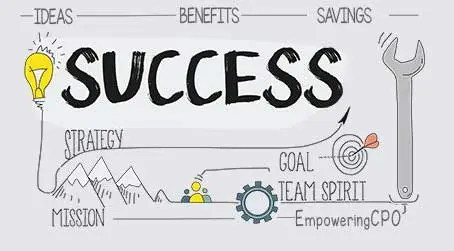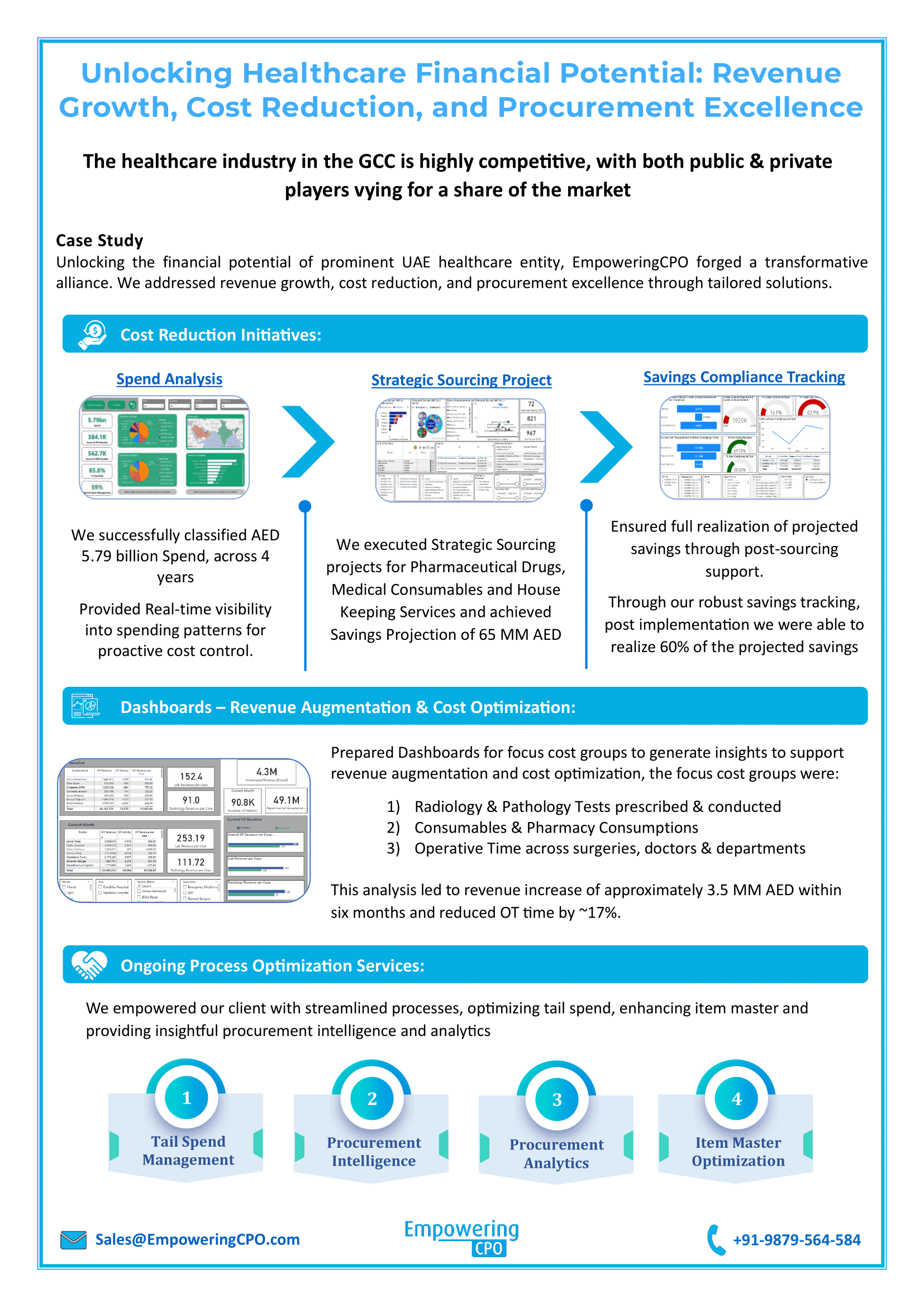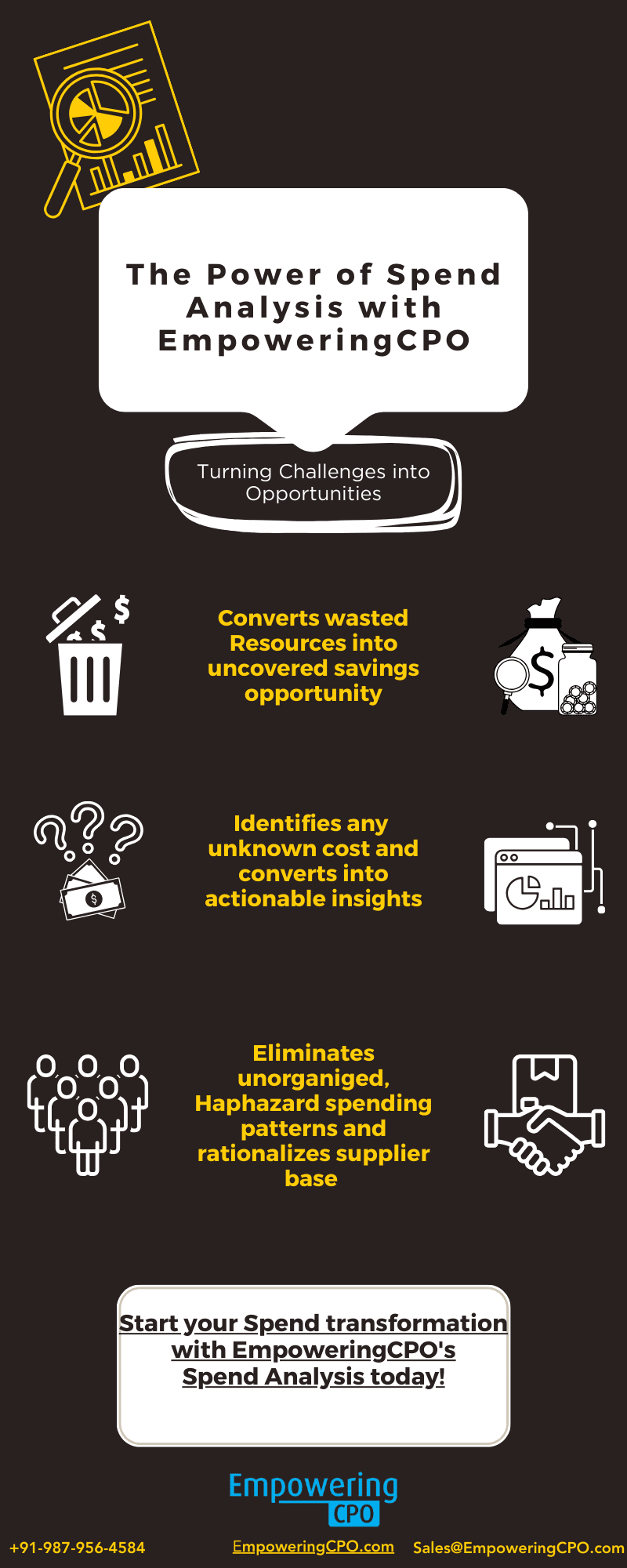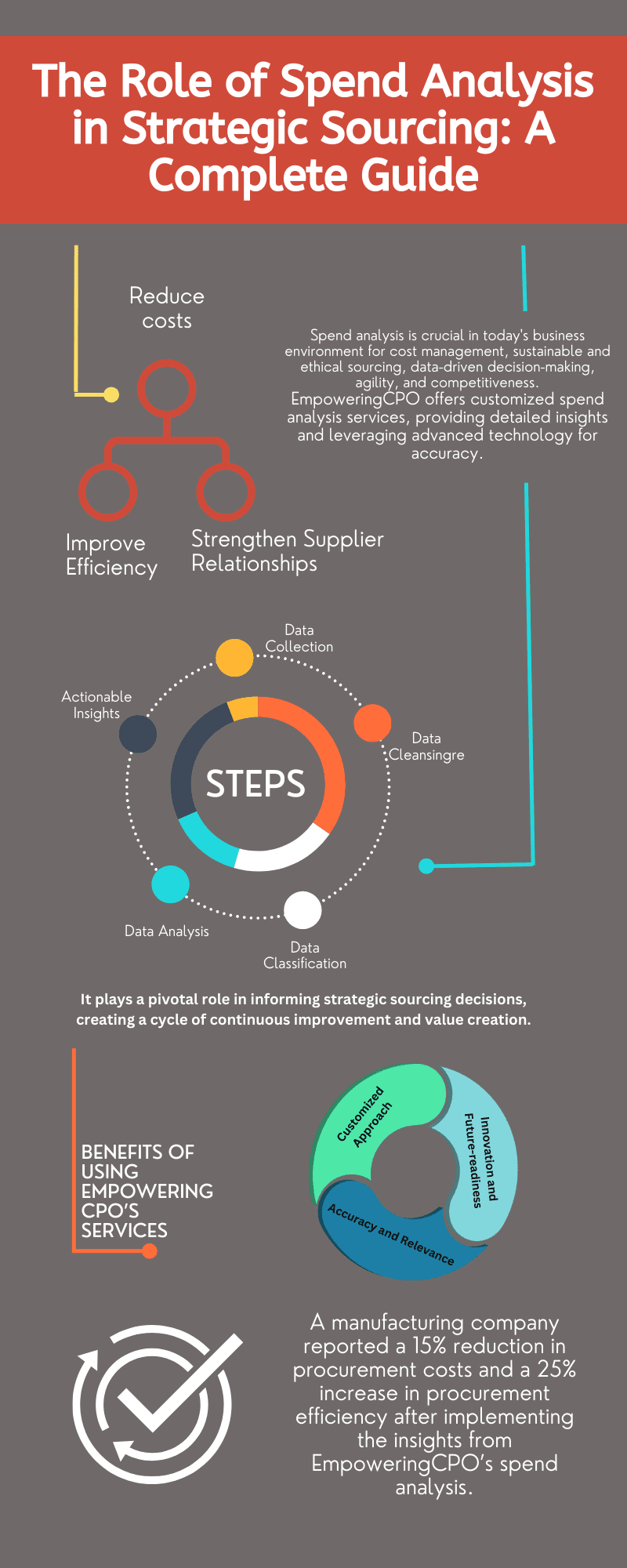
Have any questions Submit an Inquiry

EmpoweringCPO works with clients of different sizes, some of them are Fortune 300 companies based in North America. One of our clients is a $12 billion Company in the Food & Beverage segment with an annual spend of $3.5 billion. We support their procurement organization for both Direct as well as Indirect goods and services. Our association started in January 2012 and since then it has strengthened by leaps and bounds. EmpoweringCPO is considered an integral part of their procurement team; we have extensively supported them with our Procurement Intelligence and Analytics services. As is true, Procurement Intelligence & Analytics is the core ingredient for the successful execution of Strategic Sourcing projects. Procurement Intelligence & Analytics is also at the heart of the execution of assignments like – Spend Analysis, Opportunity Assessment, Supplier Diversity, Sustainable Procurement, Supplier Risk Management, and Best Cost Country Sourcing.
The engagement is aimed at supporting the client’s onsite procurement team to achieve its goals and objectives. The key result areas of our client procurement organization include:
The procurement team of our client is divided into Direct and Indirect teams led by senior management personnel (Associate Vice President – Sourcing & Supply) reporting to CPO (Vice President – Sourcing & Supply). These teams are further divided based on spending groups. Category Managers (Manager – Sourcing & Supply) are responsible for their own set of spend groups. The Category Managers are also supported by Buyers, Procurement Analysts, and Procurement Support staff. The procurement Support staff is responsible for all transactional activities involved in procure to pay process. Overall, as a team, they are responsible for managing, sourcing, and achieving the KRA listed above.
Our client currently has the following 12 Groups (Level 1) as per spend taxonomy and each group is further divided into family, category, and commodity. The commodity is the last level of classification and represents a unique set of vendors.
| Capital | MRO/ Manufacturing Services | Professional Services | Direct Material |
| Contract Services | General Services & Supplies | Marketing Materials | Packaging |
| Energy & Utilities | IT/ Telecom | Marketing Services | Logistics |
The volume of suppliers, categories, and the Spend managed by each team was huge and hence this did not allow them to devote time to strategic activities. The way the procurement organization was structured the team eventually was always overloaded and sucked into “urgent” and “un-important” activities rather than focusing on “strategic” and “important” activities.


After the engagement with EmpoweringCPO started, the first month was all about understanding the procurement organization at the client location and also the tools and systems adopted. The experience of the onsite team in the last few years, the type of initiatives, and the results achieved were discussed. After elaborate discussion EmpoweringCPO team realized the current situation and the challenges faced by the onsite team. Accordingly to overcome the difficulties an appropriate solution was designed and proposed. The solution included the deployment of 4 highly qualified offsite resources. The client was asked to participate in the selection process; the shortlisted candidates were finalized after approval from the client. All four resources had good analytical skills and were from leading Business Schools. The cherry on top was that all resources also had multiple years of procurement and sourcing skills.
The spend groups were divided into four parts and each resource was responsible for a set of groups and hence also linked to a set of onsite category managers. The offsite EmpoweringCPO resources were responsible for mirroring the KRAs of onsite category managers. The KRA’s included quantifiable numbers along parameters like annual savings, increase in Supplier Diversity, Risk Management goals, and Sustainable Procurement goals.
To ensure that the offsite model was robust and dependable proper reporting methodology was formulated. Weekly video calls with onsite teams were scheduled so as to collect feedback on an ongoing basis, provide updates on various categories and discuss upcoming categories & projects in the pipeline.
We helped our clients with executing all their strategies to achieve their KRA, the heart of our offering was Procurement Market Intelligence & Analytics. As such Procurement Intelligence & Analytics is not a standalone service and plays an important role in executing all strategies like Spend Analysis & Opportunity Assessment, Strategic Sourcing, Best Cost Sourcing Country, Supplier Diversity, Sustainable Procurement, and Supplier Risk Management.
In the last three years, we have supported onsite category managers by providing market intelligence for approximately 300 different categories of varied spending levels. The market intelligence was in areas like finding suppliers, identifying cost drivers, supplier industry trends in terms of growth, and understanding competitive rivalry among industry participants and across many other different factors. Our deliverables were helpful to them in many ways like day-to-day decision-making, helping them reduce risk, increase savings, and to discover new suppliers.
We also supported our client with data crunching and analysis-related assignments. Most of them were part of the strategic sourcing process while some of them were more about day-to-day category management. Some examples are Cost Modeling, Baseline Preparation, RFP Pricing Worksheet Preparation, Savings Calculation, TCO Analysis, and Compliance Model Preparation. All these deliverables were aimed at supporting category managers to make informed decisions instead of relying on intuitions.
One of the main KRA was savings and hence from the second month onwards, we started with Spend Analysis and Opportunity Assessment. The last 2-year data pulled from various tools and systems as well as from the main ERP system was analyzed. The taxonomy was reviewed and the spend was reclassified so that the last level would represent a unique set of suppliers, which would form sourceable buckets and would represent an RFP. After thorough analysis, the offsite team also reviewed all the categories which were more than $500,000 in annual spend. EmpoweringCPO used its proprietary opportunity assessment framework to analyze and research these categories; the categories were plotted on a graph representing “Ease of Sourcing” versus “Savings Potential”. The end result was a 3-year wave plan, with 6 waves of 6 months each. Each wave included a set of categories to be taken up for sourcing.
After submission of the Opportunity Assessment report, the categories were taken up in sets of 5-6 categories based on the Wave Plan. The EmpoweringCPO Strategic Sourcing framework was adopted to achieve savings for these categories. Thorough market research and data analysis were the bedrock of our success in achieving good savings results. In the last 3 years, we have executed more than 35 categories across various spending groups. The spending size of these categories has ranged between a minimum of $1 MM to a maximum of $60 MM. The average savings have been around 5%.
As part of the Opportunity Assessment, we also identified categories that were the right candidates for Best Cost Country Sourcing. The categories were finalized after evaluating them based on “Supply Market” and “Product” characteristics. In the last 3 years, four categories were successfully sourced, two of them from India and others from China. The project took around 11 months because of stringent requirements related to approval from regulatory authorities. For all four categories, the savings were very high in the range of 20% -35%.
To support our client with preparing and implementing the Supplier Risk Management plan we started with identifying the main focus categories. The first step was to prepare a category positioning matrix, we prepared a bubble chart for each spending group, and categories were plotted on a graph representing Business Impact versus Supplier Risk. EmpoweringCPO proprietary framework was used to prepare, classify and plot each category. As a next step, based on client feedback, we prepared a risk management plan where all vendors in the specific category were researched and evaluated. Our focus initially was high-spend categories where the number of suppliers was only one per category. We prepared a mitigation plan and identified alternate vendors that can be included in the mix. For key categories in addition to financial analysis, to ascertain stability the vendors were also researched in terms of changes in the management team, violations related to environmental laws, trade sanctions, occupational safety, health regulations, etc.
During our engagement with our client, Sustainable Procurement was identified as one of the focus areas to enhance brand reputation. To support our client we proposed and implemented programs to that effect. We identified categories that can be replaced with suppliers more efficient in terms of sustainability. Example: we were able to identify vendors for SBS paperboard who were willing to use wood pulp with high content of vegetable refuse and were able to provide similar properties. We were also able to find suppliers that were using recycled material and eco-friendly materials. In addition, research was conducted on an ongoing basis to update the performance of suppliers in terms of sustainability credentials. Our effort yielded good results and in the last three years the CSR report improved and efforts were commended by investors.
After one year of our engagement with our client, the scope of work was increased to also include the implementation of a Supplier Diversity program. This was important as a diverse supplier pool is considered a major competitive advantage and a powerful business tool. To begin with, as a first step, we cleaned the current spending data by reviewing and correcting the minority indicator for all the 4000 vendors, this allowed us to calculate the “As is” status in terms of percentage spending with minority vendors. After the baseline was established, we started the implementation plan. We leveraged our strong Strategic Sourcing capabilities to achieve this goal. Strategic Sourcing initiatives aimed at cost savings are the best vehicle to identify opportunities and increase spending with minority vendors. To achieve results along with the leading vendors we also helped them identify minority vendors for all the categories that were sourced. Our focus was the initial few steps of the strategic sourcing process, as these are very critical to the success of any Supplier Diversity program.
To ensure the engagement is effective on an ongoing basis, mutually agreed scorecards are adopted with the following parameters:
All the onsite team members are asked to rate EmpoweringCPO every 6 months, and in addition to the rating they are also asked to comment on the following two areas:
The weekly report format is also agreed to update all team members on regular basis, the report is submitted to all Category Managers on every Friday listing the following fields (columns):
At the end of three years, we were able to transform the Procurement Organization of our client into a truly strategic arm.
EmpoweringCPO is one of the leading sourcing companies in the USA, contact us to receive category-specific case studies and to know about our procurement consulting services.
EmpoweringCPO is a team of experienced sourcing and procurement professionals with hands on experience of having worked with many fortune 500 companies. The company was founded in 2011 and since then has executed multiple strategic sourcing projects and have achieved average savings of 10-12% so far. In addition to Strategic Sourcing their other offerings are Spend Analysis, Procurement Intelligence, Procurement Analytics, Best Cost Country Sourcing, Procurement Outsourcing, Built Operate Transfer, Supplier Diversity, Sustainable Procurement, Tail Spend Management, Item Master Optimization, Collective Buying, Compliance Tracking and Managed Procurement Services.




Compliance management is very critical as otherwise the procurement organization may run into a scenario where there is a huge gap between realized savings and reported savings. Many procurement functions estimate large savings numbers when contracts are signed. They also invest significant time and effort in negotiating contracts for necessary goods and services, only to have a third or more of their purchasing dollars flow outside those deals. Some of the obvious fall-outs of non-compliance and maverick purchases are:
As compared to the current contract that was finalized after the sourcing process, the tool helps in tracking:
The objective of this tool is to ensure that the orders are placed only with the vendors that were shortlisted after the sourcing process and at the same price that was agreed upon and negotiated during and after the strategic sourcing process.